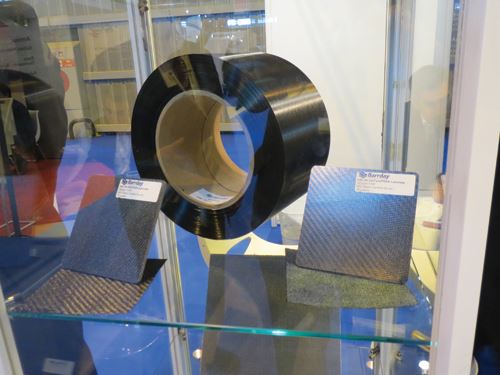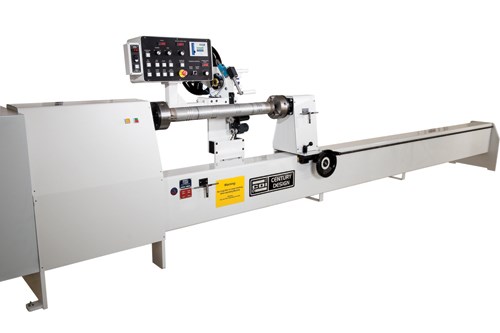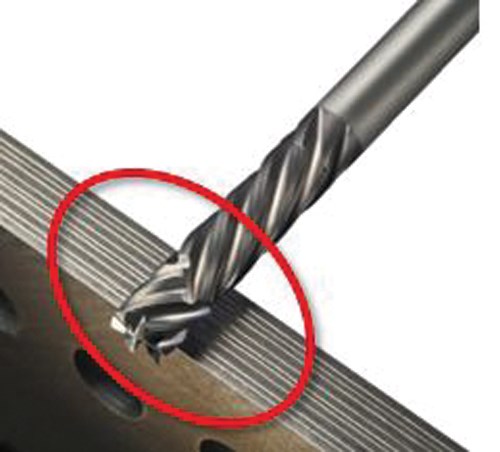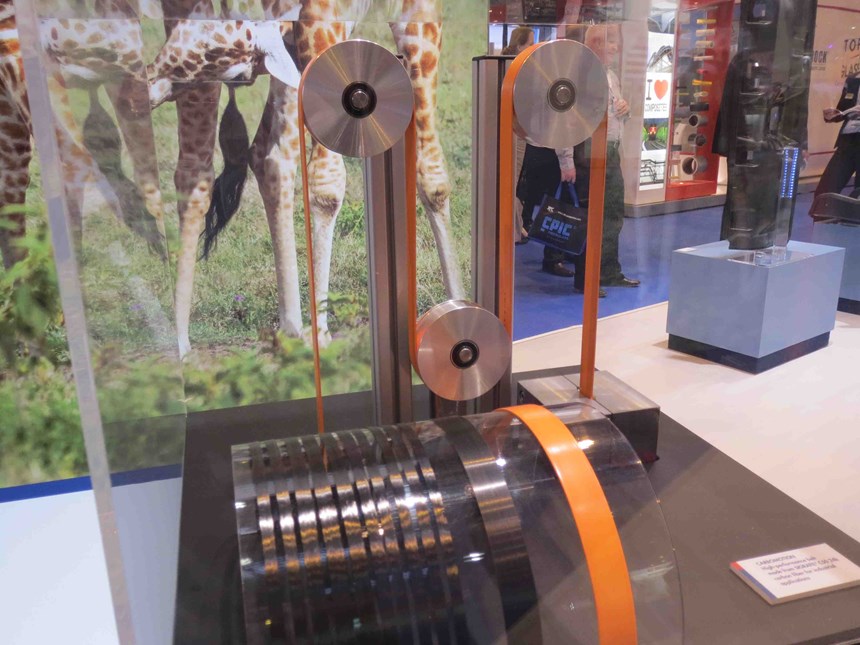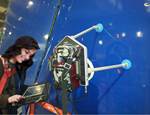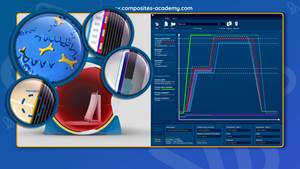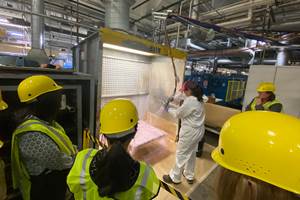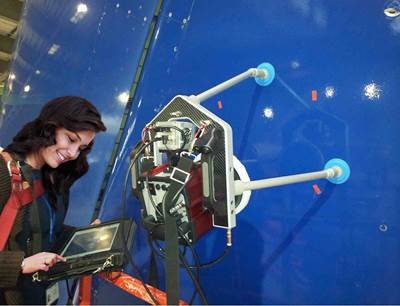2013 JEC Europe new product showcase
The JEC Europe 2013 trade show (March 12-14, at the Paris Expo, Porte de Versailles, Paris, France) was the venue for introductions of a large number of new composite materials, technologies and manufacturing processes. Here's the HPC editorial staff's compilation of what was on display.
The JEC Europe 2013 trade show (March 12-14, at the Paris Expo, Porte de Versailles, Paris, France) was the venue for introductions of a large number of new composite materials, technologies and manufacturing processes. Here's the HPC editorial staff's compilation of what was on display.
Glass yarn for PCBs
AGY Holding Corp. (Aiken, S.C.) introduced two new product lines at the JEC Europe 2013 show. Because of the growing need for miniaturization and functionality in the electronics market, ultrafine glass fiber yarns for printed circuit board substrates are a necessity. AGY’s ultrafine BC2250 and BC3000 yarns allow thinner laminates for higher layer counts and greater circuit density, while providing electrical insulation and stability. The company says BC3000 consists of 50 filaments of 4μ-diameter glass, reportedly the finest in the market. AGY also announced an expansion of its range of sizings that can work with thermoplastic resins. The new sizings are available in a range of fiber diameters, in S-2 Glass and E-glass yarns, ZenTron rovings and S-2 Glass assembled rovings. Sizing formats include a wide range of engineering resins, including polyetheretherketone (PEEK), polyetherketoneketone (PEKK), polyetherimide (PEI), polyphenylene sulfide (PPS) and many more.
Infusion molding supplies
Airtech International Inc. (Huntington Beach, Calif.) brought several new products to JEC Europe 2013. Thermalimide E is a high-performance bagging film for cure temperatures up to 426°C/799°F. Thermalimide E RBCS is a film treated on both sides with a release coating; it can be used for cure cycles up to 405°C/761°F. Flashbreaker PS1 is a high-temperature/high-tensile strength polyester film coated with a high-tack, pressure-sensitive silicone adhesive for oven or autoclave cures up to 204°C/399°F. Wrightlease 2 is a new extruded fluoropolymer pressure-sensitive tape with a silicone adhesive. Toolwright 5 is a thicker version of the same extruded fluoropolymer film that is coated with silicone pressure-sensitive adhesive. Finally, the Airtech Vacuum Test Unit is used to test the vacuum integrity of all Airtech vacuum hoses and valves, as well as the quick-disconnect couplings that are attached to these hoses and valves.
Cobalt-free curing systems
Akzo Nobel Polymer Chemistry (Amersfoort, The Netherlands, and Chicago, Ill.) reported at JEC Europe 2013 that it has extended its portfolio of cobalt-free curing solutions with the launch of its second-generation Nouryact accelerators. Based primarily on iron, the new “eco-premium” accelerators are said to work in a wide range of temperatures and have a low impact on color in end-use products. They also boast easy replacement for existing cobalt-based accelerators and in some cases have been shown to outperform cobalt, enabling cure behavior not achievable by conventional systems. All Nouryact accelerators are 100 percent cobalt free and are BlueCure products. The BlueCure umbrella brand is an initiative of AkzoNobel and DSM (Schaffhausen, Switzerland) that covers innovative cobalt-free curing technologies and products. It is available to all resin and component manufacturers in the composites industry.
Aerospace composites toolmaker
At JEC Europe 2013 , ALPEX Technologies GmbH (Mils, Austria) exhibited its capabilities in producing tooling for composites in aluminum, steel, Invar and composites. The company is involved in a number of major aerospace programs, including the following parts for the Airbus (Toulouse, France) A350 XWB: inboard and outboard flaps (layup tools, milling fixtures and assembly jigs), infusion tools for A350 XWB carbon spars and tools for resin transfer molding of window frames, pressure bulkheads and other components.
New consultancy launched
At the JEC Europe 2013 show, Michael Effing, former president of DSM Composite Resins AG (Schaffhausen, Switzerland), launched his new consultancy, AMAC GmbH (Aachen, Germany). AMAC stands for Advanced Materials Advisory and Consultancy. Effing,who previously held positions at Huntsman, Johns Manville, Owens Corning and DuPont, says AMAC aims to support the creation of networks and technology clusters between universities and industrial partners and provide training, education and complex business project support. At the show, Effing’s firm helped announce the formation of AZL, a new Center for Integrative Lightweight Production in Aachen. AZL, with 33 industrial partners teamed with the RWTH Aachen University (Aachen, Germany), aims to focus on lightweight materials and fast production for more efficient automotive products.
Unidirectional thermoplastic tapes
Barrday Composite Solutions (Millbury, Mass.) reported at JEC Europe 2013 that it has extended its thermoplastic laminate technology to unidirectional thermoplastic tapes, targeting structural applications in the commercial aerospace, military/defense and industrial markets. These products use carbon fiber and high-performance glass fiber reinforcements in polyetheretherketone (PEEK), polyetherketoneketone (PEKK), polyetherimide (PEI), polyphenylene sulfide (PPS) and polyamide (nylon) matrices. The tapes are available in a range of fiber areal weights and resin contents. The initial tape widths will run from 160 mm to 305 mm (6.25 inches to 12.0 inches). However, the equipment has been sized to produce prepregs at widths of up to 610 mm/24 inches.
Woven carbon fiber reinforcements
BITEAM AB (Bromma, Sweden), producers of three-dimensional, woven carbon fiber reinforcements for a wide range of structural applications, showed some special woven profiles developed especially for a debut at JEC Europe 2013. In particular, developer Nandan Khokar showed how different profiles can be quickly matched and joined for quick and easy modular part construction. In addition, the company can weave customized profiles for specific customer needs.
Horizontal tape placement machine
Prepregging machinery manufacturer Century Design Inc. (CDI, San Diego, Calif.) launched at JEC Europe 2013 its M777 horizontal tape placement machine. It offers precision tape placement on small- to large-diameter straight and tapered mandrels. The specially designed placement head controls the tension of the tape and its position on the mandrel during production of standardized and high-quality tubular components. CDI says the demand for such a machine has been driven by customers looking to improve manufacturing methods used to make tubular structures, such as golf shafts, fishing rods and bike frames and struts. CDI notes that these parts traditionally have been produced by rolling or filament winding. Although these methods produce good results, CDI says they do not yield the most efficient parts due to ply drop-offs and variation in resin content. With a pitch of up to 152 mm/6 inches, the M777, according to CDI, can process a variety of parts with a full range of materials and sizes. The M777 can also wrap prepreg and thin-film tapes from the same tension head. That, in turn, enables part completion on one machine. Its key features include four axes of motion, an HMI human/machine interface) touch screen, a fully pivoting tape placement head (180° of motion), dual tension control and a tension-canceling feature that allows for wrapping of long or small-diameter parts.
Programming, simulation for ATL
CGTech (Irvine, Calif.) introduced at JEC Europe 2013 new programming and simulation software for automated tape laying (ATL) machines. The new capability complements CGTech’s existing composite software applications for automated fiber placement (AFP). The capabilities are offered in three applications: VERICUT Composite Paths for Engineering (VCPe) allows the user to measure and evaluate the effects of AFP and ATL path trajectory, material steering, surface curvature, course convergence and other process constraints as they would be applied in manufacturing. The software also provides produceability analysis of the fiber angle, based on the curvature of the part, and overlap and gaps needed for structural analysis. The tape course geometry can be written to various CAD formats for further evaluation by users’ existing analysis methods and tools. VERICUT Composite Programming (VCP) reads CATIA V5, STEP and ACIS surface models. It also reads Siemens Fibersim, CATIA V5 or other external ply geometries and information. VCP then adds material to fill the plies according to user-specified manufacturing standards and requirements. The layup paths are linked together to form specific layup sequences and are output as NC programs for the automated layup machine. VERICUT Composite Simulation (VCS) reads CAD models and NC programs, either from VCP or other composite layup path-generation applications, and then simulates the sequence of NC programs on a virtual machine. Material is applied to the layup form via NC program instructions in a virtual CNC-simulation environment. The simulated material, when applied to the mandrel, can be measured and inspected to ensure the NC program follows manufacturing standards and requirements. A report showing the simulation results and statistical information can be created automatically.
Robotic fiber placement
Coriolis Composites SAS (Quéven, France) emphasized at JEC Europe 2013 its robotic fiber placement capability, qualified by major aerospace customers and customers in automotive, wind energy and sports markets. The company was involved in testing Hexcel’s (Stamford, Conn.) new HiTape dry fiber for automated layup (followed by infusion) of aerospace parts, and it recently delivered its first dry fiber placement machine to a major aerospace OEM. In addition to robotic composite fiber placement machines, Coriolis featured its CADFiber offline programming and simulation software, which enables programming of robotic manufacturing scenarios, including laminate sequence, fiber placement details and motion strategy. CADFiber is compatible with Dassault Systèmes’ (Velizy-Villacoublay, France) CATIA and DELMIA CAD programs and reportedly provides machine-independent simulation for robots and CNC machines to optimize part production.
PAN precursor creel
Cygnet Texkimp Ltd. (Cheshire, U.K.) unveiled at JEC Europe 2013 its third-generation VHD PAN precursor creel. The machine, which is already boasting seven installations at carbon fiber production companies, is said to deliver exceptional tension control, accuracy and consistency of unwind into fiber carbonization lines. It features a unique top box tension compensator fitted with incremental controls to handle PAN precursor packages of 350 kg/771 lb and larger. The company uses a series of customized procedures to build, test and calibrate the machine in-house to ensure the unit’s base tension is set before it is delivered to the customer’s site. Cygnet claims the system can be installed quickly and easily with minimal adjustments, attributing the ease to the modular, fully self-contained design of the top box, which relies on machined components for tighter, more reliable and stable controls. The VHD also features its own purpose-built lifter/loader system to ensure clean, efficient creel changeovers.
Rewoven recycled glass/carbon fiber waste
At JEC Europe 2013, multiaxial fabric producer Formax UK Ltd. (Leicester, U.K.) discussed several company initiatives, including greater use of modeling in developing its products and the development of a recycling division. Aimed at reprocessing the majority of its glass and carbon fiber waste, the latter was formally announced after the show on May 7. Working with Nottingham University (U.K.) and other research partners, Formax has begun reweaving waste material for both nonstructural and structural applications for a range of industries, and several customers are already manufacturing components using the recycled products, says Tom James, head of the company’s R&D efforts. Formax says the market for recyclate is growing, with many opportunities, and the new division is optimizing products to meet those needs, retain the value of the fiber and significantly reduce landfill waste.
Deep-draw release film
At the JEC Europe 2013 show, Fraunhofer Institute for Manufacturing Technology and Advanced Materials IFAM (Fraunhofer-Institut für Fertigungstechnik und Angewandte Materialforschung, Bremen, Germany) displayed a new, deep-draw release film called FlexPLAS. The elastic polymer film has a flexible plasma-polymer release layer that enables easy removal of large components from a mold, even when the film has been stretched by 300 percent, says Fraunhofer. It is suitable for both carbon and glass fiber-reinforced material, in female and male molds, and for vacuum infusion, wet layup and prepreg/autoclave processes. Reportedly, FlexPLAS already has been used to manufacture large carbon fiber components, with prepreg and autoclave curing, without a traditional release agent. The benefits, says Fraunhofer, include the fact that components can be in-mold coated (gel coat is applied directly to the release film); parts can painted or coated right out of the mold without pretreatment because the film leaves no residue; and cleaning the molds between mold release applications isn’t necessary.
PAN-based carbon fiber
Hyosung Corp.’s (Seoul, South Korea) Carbon Business Div. exhibited its range of Tansome PAN-based carbon fibers at the JEC Europe 2013 show. The company — which is supported by the Hyosung Group, a global provider of a range of products and services, including polyester tire cords, spandex fiber and airbag fabrics — started production at its new carbon line in Jeonju City on May 15, with a capacity of 2,000 metric tonnes (4.409 million lb) per year and a precursor capacity of 4,000 metric tonnes (8.818 million lb) per year. The annual production will expand to 6,500 metric tonnes (14.330 million lb) by 2015. The company’s high-performance carbon fibers include a high-strength grade (tensile strength of 4.9 GPa/710 ksi, and tensile modulus of 250 GPa/36.5 Msi) and an intermediate-modulus grade (tensile strength of 5.5 GPa/800 ksi, and tensile modulus of 290 GPa/42 Msi).
Automatic contacting extensometer and more
Instron (Buckinghamshire, U.K., and Norwood, Mass.) launched at JEC Europe 2013 three new materials testing products. The AutoX750 Automatic Contacting Extensometer supports the execution of testing routines that include tension, bending and compression, which are said to deliver more reliable and more accurate materials data in a shorter time. It’s accurate to ±1 µm and has a maximum travel distance of 750 mm/29.5 inches. Multiple knife-edge options make it ideal for testing various materials, including highly rigid composites, plastics and metals. Its key features include automatic gauge length positioning and automatic attachment to the test specimen, with adjustable contact force. According to Instron, reducing the inconsistencies of traditional clip-on extensometer attachments greatly improves the repeatability and reproducibility of critical test results. The AutoX750 meets the strain measurement specifications of ASTM E83, ISO 9513 and ISO 527-1 (2011). It is fully compatible with closed-loop strain control and complies with ISO 6892-1 Method A and ASTM E8.
The second product, Instron 2716-028 Precision Manual Wedge Grips, reportedly combines reliability with high precision and repeatable specimen alignment. Because of these capabilities, the wedge grips meet the stringent alignment requirements of NADCAP AC7122-1 (for nonmetal materials) and AC7101 (for metals), commonly used in aerospace. The wedge grips are designed for a nominal force of 100 kN, but they can take maximum loads of 250 kN, which reportedly makes them a good choice for demanding tensile tests with a large variety of materials, such as high-strength, fiber-reinforced polymer and other rigid materials and metals. The enclosed design resists dirt and debris. Also, the grips’ symmetrical closure is achieved via a safe and easy-to-use ratchet handle; during the test the wedge action causes the gripping force to increase in proportion to the applied load. Pull rods allow the grips to be used inside a compatible Instron temperature chamber, which provides a temperature range of -8°C to 250°C (18°F to 482°F) without changing parts or lubricants.
The third product is TrendTracker, a new results-management package for Instron’s Bluehill 3 materials testing software. It stores parameters and results obtained during mechanical testing of materials and components in a central SQL database for further processing, a function that accelerates the data analysis workflow in a test lab. According to Instron, the use of TrendTracker in a QC lab reduces the sources of variation; in an R&D lab, it makes it easier to evaluate iterations and arrive at the optimal design; and, for a high-volume centralized testing lab, it eases the distribution of results to internal customers.
Nesting software
JETCAM International (Monaco) launched at the JEC Europe 2013 show a new version of its JETCAM Orders Controller (JOC) Premium product for nesting programming. JOC Premium II is said to provide a quick way to remotely build unlimited worksheets of components for nesting, either manually or automatically. It supports multiple JETCAM Expert systems and can send CAD files for tooling to one Expert system while sending an order for nesting to another. New features include the following:
- The ability to select one or more components and immediately see which nests contain these components.
- The availability of component graphic views on all relevant screens.
- The display of cost estimates for each nest, taking into account factors such as material/scrap cost, machine/operator hourly rates and setup/uploading times.
- The capacity to construct complex assemblies, with unlimited subassemblies.
JOC Premium II runs on Windows XP, Vista, 7 and 8 in 32- and 64-bit versions.
Composites design software
At the JEC Europe 2013 show, MSC Software subsidiary e-Xstream engineering (Mont-Saint-Guibert, Belgium) introduced release 4.4.1 of its Digimat suite of software products for composites design and engineering. Digimat consists of six modules: Digimat-MF (nonlinear behavior prediction), Digimat-FE (materials FEA), Digimat-MX (model storage and exchange), Digimat-CAE (interface to structural FEA codes), Digimat-MAP (data mapping) and Micross (honeycomb sandwich panel design). New features in this release include the following:
- Modeling of long-fiber thermoplastics and woven composites.
- Matrix-based fatigue modeling.
- Periodic boundary conditions for unidrectional composites.
- New material data from Evonik and SABIC.
- Easier import of engineering data.
- Graphic user interface-based reverse engineering.
- Interface to injection-compression molding.
- Coupled analyses with thermoelastic materials.
- Cross mapping from 3-D volume to 2-D shell meshes.
Aerospace composites manufacturing
At JEC Europe 2013, MT Aerospace AG (Augsburg, Germany) showcased its fabrication expertise with parts for aircraft. On display was an air inlet assembly for the Airbus A400M military heavy lifter, made with carbon fiber/epoxy prepreg skins with a lightweight core. Also on display were high-load-capable carbon fiber floor beam struts in various lengths, designed to support main deck floor assemblies. The struts were made out of autoclave in an oven-cure process, with cocured titanium bushings. They are fully compliant with flame, smoke and toxicity requirements.
Tooling and assembly jigs
At the JEC Europe 2013 show, MTorres/Pacifica Engineering (Torres de Elorz, Spain, and Bothell, Wash.) highlighted its growth as demonstrated by new orders for machines and the addition of Pacifica Engineering to the company’s capabilities. With 65 employees and AS9100C certification, Pacifica Engineering designs and builds both metal and composite tooling, jigs and assembly tools for a wide range of OEMs, including The Boeing Co. (Chicago, Ill.), ATK (Clearfield, Utah), General Dynamics (Charlotte, N.C.), Spirit Aerosystems (Wichita, Kan.), Bell Helicopter Textron (Ft. Worth, Texas) and more. Boeing recently selected MTorres’ TORRESLAYUP automated tape laying machines to produce the horizontal stabilizer for the 787-9 Dreamliner at its expanded Salt Lake City, Utah, facility.
Spread-tow carbon fabric distribution
Oxeon (Borås, Sweden), which celebrated its 10th anniversary at the JEC Europe 2013 show, highlighted the work it is doing with the ORACLE TEAM USA America’s Cup defenders and its role as a preferred supplier of TeXtreme spread-tow carbon reinforcements to the team. Also announced shortly after the show closed: The U.S.-based distributor firm Composites One (Arlington Heights, Ill.) will now carry Oxeon reinforcements for advanced material applications.
Eco-friendly cobalt polymer accelerator
At the JEC Europe 2013 show, Pergan GmbH (Bocholt, Germany, and Marshall, Texas) launched Pergaquick CP, a new and reportedly eco-friendly, nontoxic and nonhazardous cobalt polymer accelerator product line, as a replacement for cobalt octoate (cobalt 2-ethylhexanoate), which has been identified as a carcinogenic chemical. The new accelerators are based on a “forward-looking cobalt polymer,” according to Pergan. Cobalt metal, which has been established for decades in the market, can be bound into a high-molecular-weight matrix called cobalt polymer. This reportedly decreases its bioavailability yet safeguards its curing performance. Moreover, cobalt polymer is exempted from registration, according to REACH, the European chemical regulatory agency. If REACH eventually addresses polymers, Pergan believes its Pergaquick CP products will offer a long-term solution. Pergan says a six-month study proved that the new cobalt polymer accelerators can replace classic cobalt accelerators (such as the Pergaquick C product line) on a 1:1 (metal-to-resin) ratio. Several hundred curing tests have been carried out with various ketone peroxides (MEKP, AHP, CUHP) and several common unsaturated polyester and vinyl ester resins. When users mix Pergaquick CP11, CP12 X or CP24 AX in formulations, according to the company, the dosage is the same as that used with classic products. The exception is CP40; at a maximum 4 percent cobalt, its dosage must be 2.5 times the dosage of Pergaquick C100 (10 percent cobalt), which it replaces.
Compression router eliminates splintering
Sandvik Coromant (Amsterdam, The Netherlands, and Fair Lawn, N.J.) introduced at the JEC Europe 2013 show its new CoroMill Plura high-production compression router for carbon fiber composites and other composites in which splintering is a common problem. As a compression end mill, its design combines positive and negative helix angles and six effective cutting edges. The unit’s microgeometry is said to allow for close tolerances, a surface finish accuracy within 4 µm (157.7 µinch) and high material removal rates. Common applications are found in the aerospace and automotive market sectors. The company recommends its use with a minimum material thickness of 6 mm/0.236 inch, and it suggests conventional up milling because that technique results in less vibration. Sandvik also recommends that users keep the split line in the middle of the material and remember that when the tool cuts across the fibers on the top or bottom surface, there is likely to be more splintering than when the tool cuts along the fiber direction.
Stretch-broken carbon fiber yarn
SGL Carbon SE (Wiesbaden, Germany) debuted at JEC Europe 2013 its SIGRAFIL CSBY 70, a stretch-broken carbon fiber yarn. It is processed from 50K carbon fiber tow, weighs in at 70 g/m3 and can be woven. SGL says it is working with its customers to develop applications for the yarn. SGL also featured on its stand an unusual carbon fiber belt system for load-pulling devices. The belts, demonstrated in a pulley system, are made of SIGRAFIL C50 24K carbon fiber tow infused with epoxy and coated with a bright orange thermoplastic. The belts, say SGL, can lift 3.5 to 4.0 metric tonnes (7,716 to 8,818 lb), and in testing they surpassed 10 million bending cycles with no fatigue.
Carbon spread-tow fabric and recycled noncrimp fabric
As a result of technical collaboration and development work with a number of market-leading companies in the composite industry, two significant new products from Sigmatex (UK) Ltd. (Runcorn, U.K.) were introduced at the JEC Europe 2013 show. The first, sigmaST, is a spread-tow fabric available in 50g and 75g/ply areal weights, with a heavier 100 g/ply version also in development. The width of the spread tape is 16 mm/0.63 inch, which is woven by a new, state-of-the-art, high-output production process to form a near-zero crimp fabric. Narrower tapes are in development, says Andrew Ball, lead development engineer for multiaxial fabrics at Sigmatex.
The second new product is sigmaRF, a recycled/reclaimed carbon fiber noncrimp +45°/-45° multiaxial flexible fabric woven from 55-mm/2.2-inch recycled carbon staple fibers blended with a thermoplastic fiber. The fabric contains about 48 percent carbon, by volume, and has a significantly lower environmental impact than virgin carbon fiber-based materials. The fabric is targeted to the automotive market, primarily for nonstructural parts made with standard thermoplastic processes, where surface finish isn’t an issue.
Thermoplastic prepregging equipment
At the JEC Europe 2013 show, Van Wees UD and Crossply Technology BV (Tilburg, The Netherlands) showcased its capability in machine manufacturing for technical textiles. New at the show was the company’s multiaxial unidirectional (UD) crossply machine for making thermoplastic prepreg. After unwinding the roving and spreading it into a continuous layer for impregnation with the resin, the machine integrates the splicing and lamination steps into a continuous process and has the capacity to change the crossply angle from 45° to 90°, giving the user the option to assemble multilayer thermoplastic laminates. The spreader bars are heated, and impregnation with the thermoplastic matrix is reportedly highly effective, enabling high-output production.
One testing machine, 100 test standards
Zwick USA (Ulm, Germany, and Kennesaw, Ga.) introduced at JEC Europe 2013 its Allround-Line testing machine that is designed to set a new standard in static materials testing. This one modular tester reportedly covers 21 types of tests and can conform to 115 standards over a wide temperature range. It is said to be ideal for fiber-reinforced composites whose properties depend on fiber alignment, the fiber, the matrix and the fiber/matrix interface. The machines are available with a force range starting at 5 kN and, depending on the requirements and force range, is available in either flatbed or column format. Patented hollow-profile or classical column guides are said to guarantee maximum stiffness and precise crosshead guidance, providing a basis for accurate, traceable test results. The core of the Allround-Line is the new testControl II control electronics, said to provide precise, reproducible test results. The key features include new drive technology, high measured-value acquisition rates, a modular design and a high safety standard.
Related Content
New online training course targets prepreg basics
JEC World 2024: Composites Expert highlights how its E-Learning Composites Academy platform supports flexible industry learning with new courses developed with Stelia Aerospace North America.
Read MoreAMRC Training Centre introduces composites apprenticeship opportunity
With partners McLaren and Teledyne CML Composites, the Training Center will train new composites technicians in South Yorkshire to build up the future industry workforce.
Read MoreToray, University of Chicago speed up polymer recycling R&D
A jointly developed multi-scale computational predictive technique can accurately predict viscoelasticity from the chemical structures of polymers, ramping up product maturation.
Read MoreWomen in the Composites Industry brings together women for networking, educational opportunities
Aiming to support the growth of women in this industry, the WCI industry group and its partners recently held its first live training event hosted by Owens Corning.
Read MoreRead Next
SAMPE 2013 Long Beach new product showcase
The SAMPE 2013 trade show (May 6-9, in Long Beach, Calif.) was the venue for introductions of a large number of new composite materials, technologies and manufacturing processes. Here's the HPC editorial staff's compilation of what was on display.
Read MoreVIDEO: High-volume processing for fiberglass components
Cannon Ergos, a company specializing in high-ton presses and equipment for composites fabrication and plastics processing, displayed automotive and industrial components at CAMX 2024.
Read More
